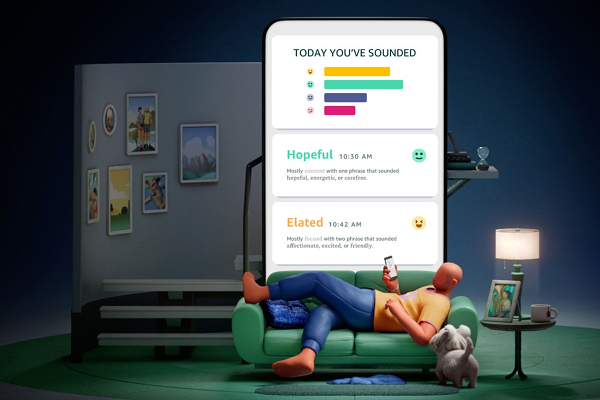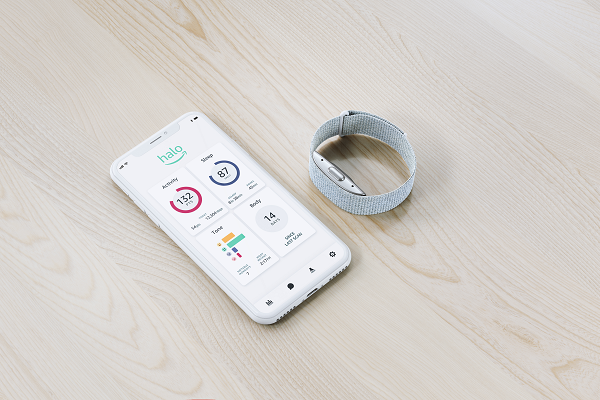Amazon’s New Halo Fitness Band Excludes Alexa and Judges Your Tone of Voice
 Amazon has launched a smart fitness wearable and accompanying app named Halo for early access by request. Halo combines sensors on the Halo Band device with advanced artificial intelligence to generate insights into a wearer’s health with an accuracy that Amazon says is comparable to a doctor. Though the band includes two microphones, Amazon’s Alexa voice assistant is entirely absent. Instead, the microphones are for the new Tone feature, which analyzes the sound of a wearer’s voice, reporting how they might sound to others. The feature literally polices a user’s tone by judging their mood and energy and suggesting they think more about it.
Amazon has launched a smart fitness wearable and accompanying app named Halo for early access by request. Halo combines sensors on the Halo Band device with advanced artificial intelligence to generate insights into a wearer’s health with an accuracy that Amazon says is comparable to a doctor. Though the band includes two microphones, Amazon’s Alexa voice assistant is entirely absent. Instead, the microphones are for the new Tone feature, which analyzes the sound of a wearer’s voice, reporting how they might sound to others. The feature literally polices a user’s tone by judging their mood and energy and suggesting they think more about it.
Healthy Halo
The Halo Band looks much like a discreet bracelet similar to a Fitbit. The water-resistant hardware is packed with a heart rate monitor, accelerometer, and other sensors in addition to the microphones. Halo gathers and analyze health metrics to report on activity levels, and time spent in different stages of sleep, among other health metrics. Notably, Halo includes a feature called Body that applies Amazon’s computer vision technology to wellness by guiding users into taking photos that it combines into a three-dimensional body model for measuring body fat percentage. The app includes a slider to adjust the body fat percentage and show the user how their body shape might change in turn.
 The Tone feature stands out even among the other Halo offerings. The microphones measure aspects of voice like speed, pitch, rhythm, and intensity to build a picture of your mood as others would react to it. It requires setting up a voice profile in the Halo app by reading out quotes until the AI can distinguish your voice. Without a profile, the microphones are supposed to stay off. Once set up, Tone runs in the background, randomly recording short bits of you talking for irregular updates. Tone can also be activated manually, recording up to half an hour, and providing real-time analysis. Amazon suggests that it would be useful for practicing speeches and related activities.
The Tone feature stands out even among the other Halo offerings. The microphones measure aspects of voice like speed, pitch, rhythm, and intensity to build a picture of your mood as others would react to it. It requires setting up a voice profile in the Halo app by reading out quotes until the AI can distinguish your voice. Without a profile, the microphones are supposed to stay off. Once set up, Tone runs in the background, randomly recording short bits of you talking for irregular updates. Tone can also be activated manually, recording up to half an hour, and providing real-time analysis. Amazon suggests that it would be useful for practicing speeches and related activities.
“Tone complements traditional metrics like sleep and activity by helping you understand how you sound to others,” Amazon Halo principal medical officer Dr. Maulik Majmudar explained in a blog post about the feature. It uses machine learning to analyze the positivity and energy of your voice—positivity is measured by how happy or sad you sound, and energy is how excited or tired you sound. The Amazon Halo app then turns that analysis into daily summaries that include easy-to-understand descriptors—for example you might see that in the morning you sounded calm, delighted, and warm.”
Tone and the other wellness tools are built into Halo, which Amazon is setting up as a subscription service. Those with early access pay $65 for a six-month membership, which includes the wristband, but the price will rise to $100 for six months once Halo rolls out to more customers. For that price, the absence of Alexa is a glaring gap in the list of features. It’s especially odd for Amazon to omit the voice assistant after Google Assistant joined Alexa on the latest Fitbit smartwatches, a year after Alexa exclusively appeared on the Versa 2. s especially notable. As Google announced in November that it will buy FitBit for $1.2 billion, Alexa may be looking for a new fitness home soon, and apparently there’s no room on Halo.
Watch Your Tone
Voice AI that can detect and identify emotion is not itself a new concept. Car companies have begun experiments on using a voice assistant to suggest a driver pull over if they sound very tired, for instance. Using that analysis as not only mood indicator, but for encouraging behavioral changes in tandem with better diet and exercise is far less common. Voices are more complex than heart rates, it’s hard to imagine a few brief readings for a voice profile would be enough to teach the AI everything it needs to know what every variation in someone’s voice means. Amazon makes a point of highlighting Halo’s privacy measures, including keeping all voice data on the device and the ability to delete collected results at any time. But how much can the AI learn when restricted from the data and computational resources in the cloud. Can Tone detect deliberate intonations like sarcasm out of the box, or tell if a voice is raised just to speak to someone standing far away?
Even if the tech is able to do everything Amazon claims, there’s a big question mark hanging over why someone would use this. People usually know their own mood without quantifying their vocal excitement, although perhaps it may be useful for neurodiverse people to improve their communication skills. Otherwise, Tone comes off, somewhat ironically, as an incredibly tone-deaf concept. The intent of the developers behind Tone may be entirely earnest and sincere, but it comes off as telling someone to be sound happier and more energetic than they may feel. An informal poll of some fitness band users about Tone provoked varying degrees of visceral disgust, with more than one woman referencing being told that women need to watch their tone at work and “always sound like they are smiling.” Tone may or may not be a turn-off for a lot of potential customers, but no voice assistant and Halo’s approach to smart fitness tech
Follow @voicebotai Follow @erichschwartz
Fitbit Adds Google Assistant to New Versa 3 and Sense Smartwatches, Keeps Alexa Option
Google Will Acquire Fitbit for $2.1 Billion and Strengthen its Google Assistant Wearables Strategy








